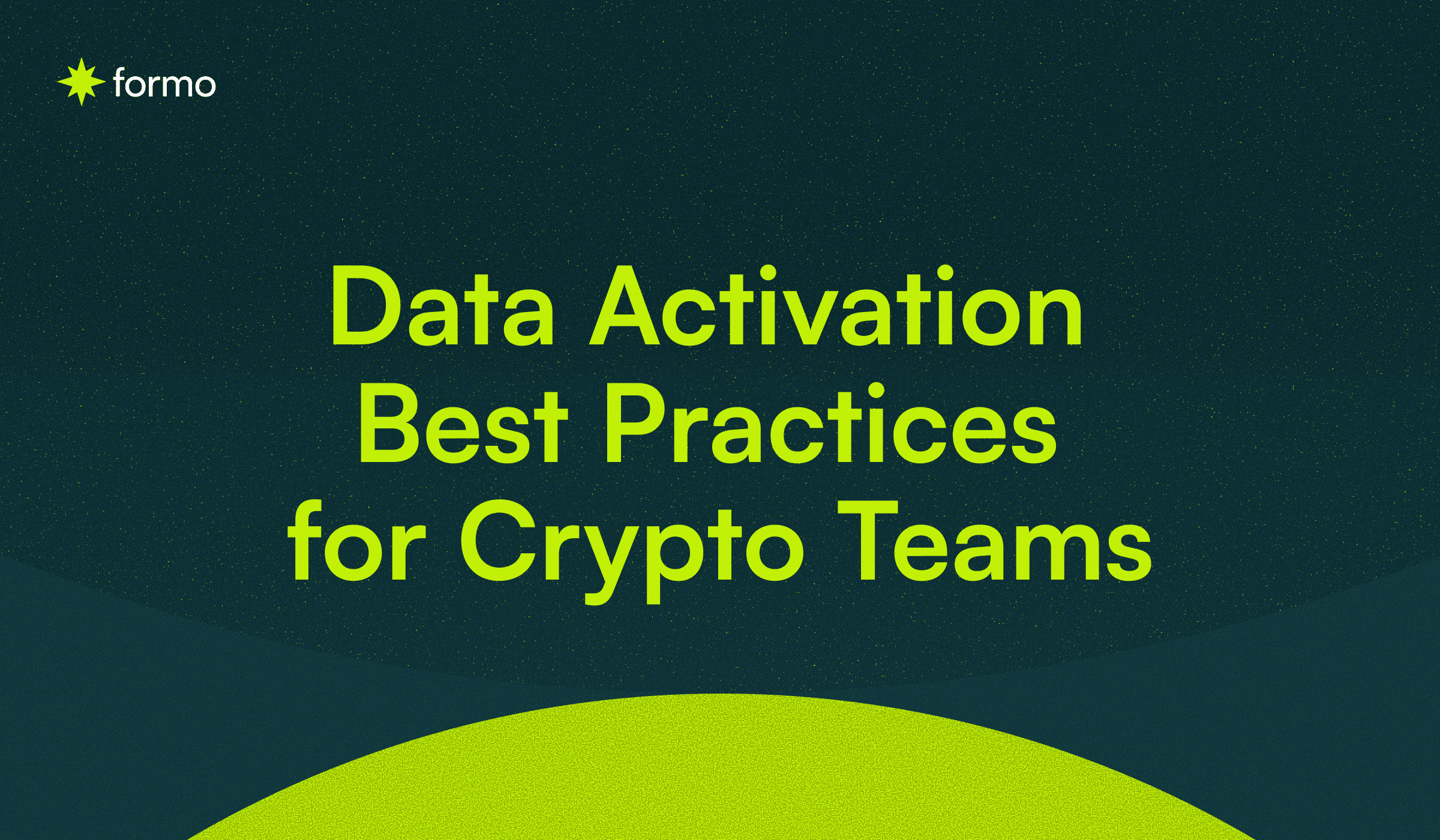Understanding who visits your website and buys your products is a powerful way to grow your brand, but many projects fail to get to know their Web3 customers deeply enough. To better understand your users, creating customer personas is an effective strategy. In this guide, you will learn about Web3 Customer Personas, how they can benefit your product and service, and how to create them.
Key Takeaways:
Web3 Customer Personas are semi-fictional profiles built from onchain and offchain data to represent ideal users.
Personas help tailor product features, improve marketing, and guide community-building.
Effective personas include demographics, behaviors, interests, and pain points.
Use data from surveys, onchain analytics, and social media to build accurate personas.
Formo helps Web3 teams collect user insights and define meaningful personas at scale.

Personas play a vital role in helping businesses tailor their web3 products, services, and marketing strategies
What are Web3 Customer Personas?
Customer personas are semi-fictional profiles of ideal customers based on quantitative data, market research, and user behavior. In Web3, customer personas can include both offchain and onchain data such as their behavior, interests, digital asset ownership, transaction history, and wallet activity.
These user profiles inform marketing strategies, align sales communications, and enable targeted messaging to reach the desired audience. By creating customer personas, brands can move beyond assumptions and demographic guesswork and instead leverage deep audience research and data to target their customers precisely.
Why are Web3 personas important?
Customer Personas are essential for Web3 startups looking to validate and expand their customer base. These detailed profiles of ideal customers enable startups to effectively segment their market, create value propositions that resonate with customers, design features and solutions that solve real problems, test assumptions and hypotheses using customer feedback, and align their team and stakeholders around a customer-centric vision.
Here are some main benefits of Web3 personas:
Tailor user experiences
Creating personas helps organizations better understand their target audience and tailor their Web3 products and services to provide a more engaging and satisfying user experience.
Build purposeful communities
Personas can help organizations identify and connect with potential community members who share common interests and goals. This can lead to more meaningful and collaborative relationships within the community.

Personas help Web3 teams understand their target audience's needs and preferences
Improve marketing effectiveness
Web3 product and marketing teams can gain valuable insights into their target audience by creating personas to develop marketing campaigns that align with their interests and values.
Encourage user participation
Web3 encourages engagement through token incentives. Companies can use personas to target motivated users and create effective campaigns.
How to create Web3 Customer Personas?
Creating effective customer personas requires integrating real-world data to accurately define your customer base. Follow the steps below to create Web3 Customer Personas:

Personas guide the design and development of products to make them resonate with the target audience
Research
Start by capturing data on current customers and potential leads, looking at demographics (age, gender, location), psychographics (values, interests, behaviors), and pain points. For Web3 audiences, delve into their understanding of blockchain technology, enthusiasm for cryptocurrency, and their onchain activities (minting, trading, transferring). Explore these typical persona research methods.
Social analytics: Use social media to analyze user sentiment, identify pain points, and understand customer perceptions of your brand. This approach helps you identify areas for improvement and incorporate valuable feedback into your personas.
Surveys, questionnaires, and interviews: Use web3 surveys and interviews as an effective way to uncover user pain points. Offer incentives to encourage participation and ask about site experiences, brand perceptions, and reasons for engaging with your company. Ask open-ended questions to encourage detailed feedback.
Check-in with your customer service team: Collect feedback from customer service teams on frequently asked questions, common themes, and recurring complaints to identify strengths and weaknesses in your offerings. Consider having customer service conduct interviews to gather additional insights that can inform your personas.
Identify Patterns
Analyze data to identify commonalities and trends among your target audience. Leverage website, social media, and onchain analytics to uncover customer behavior patterns and preferences. Objectively evaluate how to address pain points and deliver value. Trends in Web3 user activity and adoption can be identified by analyzing the volume, frequency, and size of transactions.

By monitoring onchain patterns, Web3 projects can make more informed decisions on their marketing strategies
Segmentation
Segment similar customers into different persona groups, each representing a specific audience behavior. Understanding each persona is critical to shaping messaging and campaign development. Use this understanding to create targeted marketing that addresses their unique needs and interests.
Persona Creation
After segmenting, identify common audience characteristics to create targeted marketing personas. Consider these attributes:
Demographics: Age, gender, location, education, income.
Behaviors: Actions taken on your website or onchain, and the motivations behind those actions.
Interests: Audience interests, topics, and pain points.
Some examples of personas in Web3
Give each persona a name and a backstory that outlines their goals, challenges, preferences, and how your offering addresses their needs. Here are a few examples of Web3 customer personas:
Crypto Enthusiast
Crypto enthusiasts are passionate about cryptocurrencies and blockchain, often young adults attracted by high returns. They stay informed by following leaders, engaging on social media, and learning key concepts to make informed decisions as the space evolves.

Example of crypto enthusiast personas in Web3
Digital Nomad
Digital nomads are remote workers who use technology and the Internet to work while traveling. They are interested in Web3 technology because it allows them to work and earn income from anywhere in the world.

Example of digital nomad personas in Web3
Gamer
This individual is enthusiastic about gaming and virtual worlds, driven by the potential to earn income and own assets in these virtual environments through NFTs and other Web3 technologies.

Example of gamer personas in Web3
How to use personas to guide your decisions and actions
Personas help validate product-market fit, shape value propositions, guide marketing and sales strategies, and inform product design. It also helps facilitate testing and measure product performance. Aligning with personas enables Web3 startups to meet customer needs, deliver value, and stay focused on their target audience. Regularly referencing personas helps maintain audience alignment.
Define Web3 Customer Personas with Formo
Formo Web3 Forms empowers Web3 product and marketing teams to collect valuable feedback from their target audience. By posing targeted questions, Web3 marketers can gain deep insights into their audience's needs, interests, and preferences. This information can be leveraged to develop precise personas and create highly targeted marketing campaigns.

Define customer personas and build better products with Formo
Web3 Customer Personas are a critical tool for teams seeking to connect with their users and customers in the world of Web3. By understanding the needs and preferences of their target audience, Web3 teams can develop more personalized and engaging products and communities.
Further sources:
Follow us on LinkedIn and Twitter, and join our community to see how Web3 leaders use Formo to drive growth in less time.
FAQs
1. What are Web3 Customer Personas?
Web3 personas are profiles of ideal users based on behavior, interests, wallet activity, and demographics, used to guide product, marketing, and community decisions.
2. Why are customer personas important in Web3?
Web3 personas help teams understand user needs, validate product-market fit, and create more targeted, user-centric experiences in Web3 environments.
3. How do I create Web3 personas?
Use research methods like surveys, interviews, onchain analytics, and customer support insights to identify trends and segment users into persona groups.
4. What types of personas are common in Web3?
Examples include the Crypto Enthusiast, Digital Nomad, and Gamer, each with unique goals, challenges, and motivations tied to Web3 behavior.
5. How can Formo help with persona creation?
Formo enables teams to collect user feedback through wallet-verified forms, helping build accurate personas and launch more effective campaigns.





